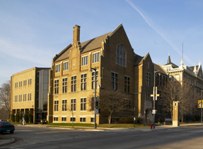Flint Water: Author Describes a Clear Crisis and Unclear Answers on Accountability
Anna Clark admits there are thing she wishes she could have probed in greater depth for her critically-praised 2018 book, The Poisoned City: Flint’s Water and the American Urban Tragedy. At the top of that list is the broad question of accountability for the actions that led to a nightmare crisis of lead contamination in water in the city near Detroit.
At the conclusion of an “On the Issues with Mike Gousha” program Wednesday at Marquette Law School, Clark said, “There are lot of unanswered questions.” Investigations of Flint’s water problem are continuing, she said, and she had to stop work on the book at some point.
“If I had more time and more space, I would love to devote it to following a little more what this accountability question looks like,” Clark said. She said that her concern apples not only to Flint but also more broadly to questions of who and what to hold accountable when major environmental harm is uncovered anywhere.


